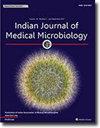‘Effectiveness of various sulbactam-based combination antibiotic therapy in the management of ventilator-associated pneumonia caused by carbapenem-resistant Acinetobacter baumannii in a tertiary care Health centre’
IF 1.4
4区 医学
Q4 IMMUNOLOGY
引用次数: 0
Abstract
Objective
Carbapenem-resistant Acinetobacter baumannii (CRAB) is a common cause of ventilator-associated pneumonia (VAP). Some in vitro data favour various combination antibiotic therapy. However, there is a need for more in vivo studies for the management of VAP caused by CRAB. This retrospective study was done to evaluate the effectiveness of various combination antibiotic therapy including sulbactam on outcomes of VAP caused by CRAB.
Methods
Adult patients (age ≥18 years) diagnosed with VAP caused by CRAB were included. Patients with polymicrobial infections were excluded from the study. Patients with CRAB associated VAP who were given sulbactam based antibiotic combinations were observed for outcomes. The primary outcome was 28-day mortality after diagnosis of VAP caused by CRAB. Reduction in serum HsCRP (High sensitivity C-reactive protein) during treatment and requirement of inotropes were the secondary outcomes. Outcomes were compared between various sulbactam based antibiotic combination therapies.
Results
A total of 103 patients were included. A total of 44 (42.7 %) patients received sulbactam and minocycline or sulbactam and polymyxin B dual antibiotic combination, and 59 (57.3 %) patients received sulbactam, polymyxin B and minocycline triple antibiotic combination. The percentage difference in 28 days mortality was 27.51 % (95 % CI 8.03 %–44.06 %; p = 0.005) in dual vs triple sulbactam based antibiotic combination therapy. The percentage difference in requirement of inotropes during therapy and HsCRP reduction after 7 days of therapy was 23.65 % (95 % CI 6.43 %–38.3 %; p = 0.007) and 25.1 % (95%CI 10.1 %–38.2 %; p < 0.001) respectively when compared between dual vs triple sulbactam based antibiotic combination therapy.
Conclusion
Treatment with sulbactam, polymyxin B and minocycline combination antibiotic therapy was associated with significantly lower 28-day mortality. Moreover, the lower requirement of inotropes during treatment and a significant reduction in HsCRP level favours this combination antibiotic therapy in VAP caused by CRAB.
在一家三级医疗保健中心治疗由耐碳青霉烯类鲍曼不动杆菌引起的呼吸机相关性肺炎时,基于舒巴坦类药物的多种联合抗生素疗法的效果"。
目的:耐碳青霉烯类鲍曼不动杆菌(CRAB耐碳青霉烯类鲍曼不动杆菌(CRAB)是呼吸机相关性肺炎(VAP)的常见病因。一些体外数据支持各种联合抗生素疗法。然而,在治疗由 CRAB 引起的 VAP 方面还需要更多的体内研究。这项回顾性研究旨在评估包括舒巴坦在内的各种抗生素联合疗法对 CRAB 引起的 VAP 的疗效:纳入诊断为 CRAB 引起的 VAP 的成人患者(年龄≥ 18 岁)。研究排除了多微生物感染患者。对接受舒巴坦类抗生素联合治疗的 CRAB 相关 VAP 患者进行疗效观察。主要结果是确诊 CRAB 引起的 VAP 后 28 天的死亡率。治疗期间血清 HsCRP(高敏 C 反应蛋白)的降低和肌注的需求是次要结果。对不同舒巴坦类抗生素联合疗法的疗效进行了比较:结果:共纳入 103 名患者。结果:共纳入 103 例患者,其中 44 例(42.7%)患者接受了舒巴坦和米诺环素或舒巴坦和多粘菌素 B 双抗生素联合疗法,59 例(57.3%)患者接受了舒巴坦、多粘菌素 B 和米诺环素三抗生素联合疗法。舒巴坦双联疗法与舒巴坦三联疗法的 28 天死亡率差异为 27.51%(95% CI 为 8.03% 至 44.06%;P=0.005)。治疗期间肌注需求的百分比差异为 23.65%(95% CI 6.43% 至 38.3%;P=0.007),治疗 7 天后 HsCRP 降低的百分比差异为 25.1%(95%CI 10.1% 至 38.2%;P=0.007),治疗 7 天后 HsCRP 降低的百分比差异为 25.1%(95%CI 10.1% 至 38.2%;P=0.007):舒巴坦、多粘菌素 B 和米诺环素联合抗生素疗法可显著降低 28 天死亡率。此外,治疗期间对肌注药物的需求较低,HsCRP水平显著降低,这有利于对CRAB引起的VAP采用联合抗生素疗法。
本文章由计算机程序翻译,如有差异,请以英文原文为准。
求助全文
约1分钟内获得全文
求助全文
来源期刊

Indian Journal of Medical Microbiology
IMMUNOLOGY-
CiteScore
2.20
自引率
0.00%
发文量
154
审稿时长
73 days
期刊介绍:
Manuscripts of high standard in the form of original research, multicentric studies, meta analysis, are accepted. Current reports can be submitted as brief communications. Case reports must include review of current literature, clinical details, outcome and follow up. Letters to the editor must be a comment on or pertain to a manuscript already published in the IJMM or in relation to preliminary communication of a larger study.
Review articles, Special Articles or Guest Editorials are accepted on invitation.
 求助内容:
求助内容: 应助结果提醒方式:
应助结果提醒方式:


